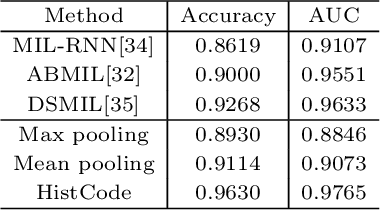Dachuan Zhang
Contrastive learning-based computational histopathology predict differential expression of cancer driver genes
Apr 27, 2022



Abstract:Digital pathological analysis is run as the main examination used for cancer diagnosis. Recently, deep learning-driven feature extraction from pathology images is able to detect genetic variations and tumor environment, but few studies focus on differential gene expression in tumor cells. In this paper, we propose a self-supervised contrastive learning framework, HistCode, to infer differential gene expressions from whole slide images (WSIs). We leveraged contrastive learning on large-scale unannotated WSIs to derive slide-level histopathological feature in latent space, and then transfer it to tumor diagnosis and prediction of differentially expressed cancer driver genes. Our extensive experiments showed that our method outperformed other state-of-the-art models in tumor diagnosis tasks, and also effectively predicted differential gene expressions. Interestingly, we found the higher fold-changed genes can be more precisely predicted. To intuitively illustrate the ability to extract informative features from pathological images, we spatially visualized the WSIs colored by the attentive scores of image tiles. We found that the tumor and necrosis areas were highly consistent with the annotations of experienced pathologists. Moreover, the spatial heatmap generated by lymphocyte-specific gene expression patterns was also consistent with the manually labeled WSI.
IFoodCloud: A Platform for Real-time Sentiment Analysis of Public Opinion about Food Safety in China
Feb 17, 2021



Abstract:The Internet contains a wealth of public opinion on food safety, including views on food adulteration, food-borne diseases, agricultural pollution, irregular food distribution, and food production issues. In order to systematically collect and analyse public opinion on food safety, we developed IFoodCloud, a platform for the real-time sentiment analysis of public opinion on food safety in China. It collects data from more than 3,100 public sources that can be used to explore public opinion trends, public sentiment, and regional attention differences of food safety incidents. At the same time, we constructed a sentiment classification model using multiple lexicon-based and deep learning-based algorithms integrated with IFoodCloud that provide an unprecedented rapid means of understanding the public sentiment toward specific food safety incidents. Our best model's F1-score achieved 0.9737. Further, three real-world cases are presented to demonstrate the application and robustness. IFoodCloud could be considered a valuable tool for promote scientisation of food safety supervision and risk communication.
 Add to Chrome
Add to Chrome Add to Firefox
Add to Firefox Add to Edge
Add to Edge